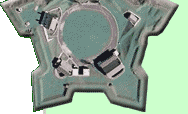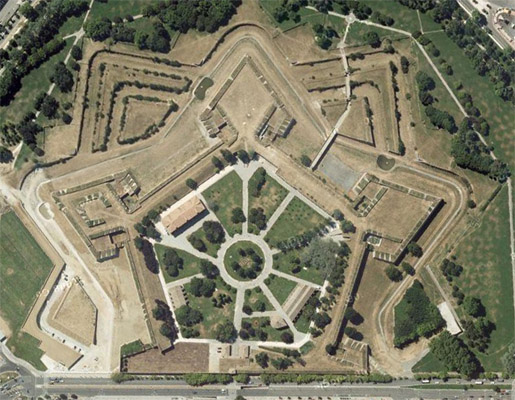
 |
 |
Ciudadela de Pamplona Pamplona, Spain |
 |
 |
 |
 |
 |
||
 |
In the 16th century, Pamplona was the capital of Navarre, a region in northern Spain that ran along the Pyrenees. The Kingdom of Spain had absorbed the southern half of Navarre in 1515, while the nothern half was similarly absorbed by France. Spanish King Felipe II (1527-1598) ordered the construction of a fort in Pamplona in 1571, similar to an Italian-styled fortress recently built in Antwerp Belgium, in the interest of solidifying his power in Navarre. Pamplona's Citadel was strengthened through the 17th and into the 18th centuries, the latter with improvements inspired by Vauban's work in France. Speaking of France, the Ciudadela's only defeat took place at the hands of Napoleon (1769-1821)'s army on February 16, 1808, though not by siege, the standard method of such a fort's undoing. Thanks to the Treaty of Fontainbleu (1807), Napoleon had permission to march through northern Spain on his way to Portugal. The French army took up residence in Pamplona while "passing through." Playful and apparently unarmed French soldiers began throwing snowballs at the Ciudadela's garrison. The garrison, not to be outdone in infantilism, gleefully dropped their weapons in order to scoop up snow and throw it back. The French snowballers produced hidden weapons and dashed into the fort, capturing it from a bunch of Spaniards standing there with their mouths hanging open, armed with snowballs. Visit Fort Manoel's page for a story of similar Napoleonic sneakiness. The Spanish Civil War (1820-1823) was fought between pro- and anti-royalist forces as a result of the mess that Napoleon made of Europe. The Ciudadela was manned by liberal forces in 1823, and were attacked by the Hundred Thousand Sons of St. Louis (who actually numbered around 60,000, but who was counting?), a force sent forth by French King Louis XVIII (1755-1824) to restore King Ferdinand VII (1784-1833) to the Spanish throne. The liberal forces held out for five months, before heavy artillery bombardments in September 1823 forced them to surrender. During the more recent Spanish Civl War (1936-1939), 298 of Pamplona's residents were executed at the Ciudadela by those nasty fascists. A plaque honoring those who died was affixed to the fort in 2007. Pamplona's Citadel ceased to be a military post in 1964. In 1971 the Ciudadela's five-pointed perfection was marred by the removal of the two bastions designed to defend against the city, perhaps because the threat of Pamplonan residents rising against Spain to reclaim the glory of Navarre had passed: New buildings and a major road were built on the newly opened ground. City officials queried residents as to what role they thought the demilitarized fort should fulfill in 1971, and the answer was "green with restored historic buildings zone," whatever that meant. Today the Ciudadela is a lovely gardened area where cultural events are regularly held. One hopes they're wary of Frenchmen with snowballs. |
 |
 |
||
|
|
|||||||
Info Source 1
Info Source 2
Info Source 3
Info Source 4
Info Source 5 Info Souce 6 Info Source 7 Info Source 8 Info Source 9 Info Source 10 Thanks to Google Maps for the image! ©2010 starforts.com |
 |